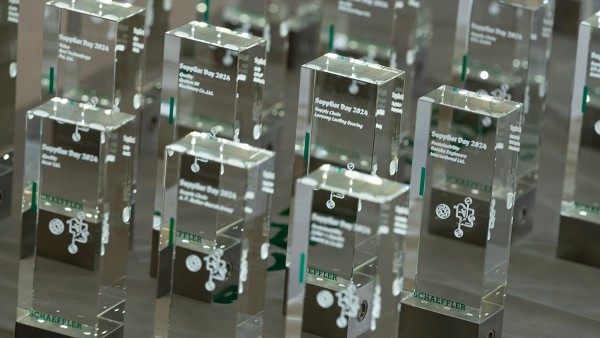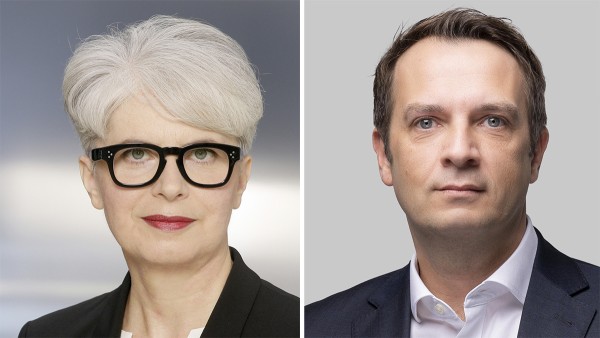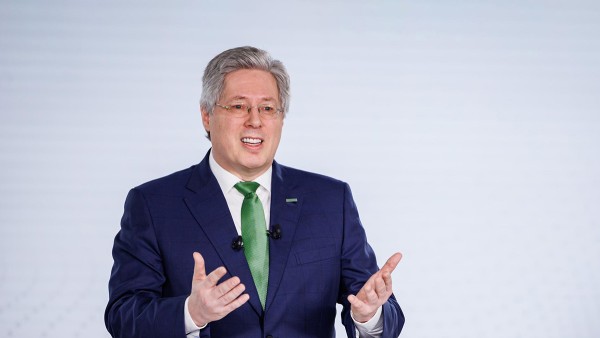Schaeffler presents interim report for the first half of 2019

2019-08-06 | Herzogenaurach
- Revenue of 7.2 billion euros for the first six months decreased slightly at constant currency in persistently difficult market environment (down 0.8 percent)
- EBIT margin before special items of 7.7 percent below prior year (11.0 percent), quarterly earnings quality improved in first six months
- Industrial division business remains strong while revenue and earnings of the two Automotive divisions decline
- Free cash flow before cash in- and outflows for M&A activities of minus 229 million euros below prior year (minus 75 million euros), amount positive in second quarter (6 million euros)
- Full-year guidance adjusted on July 29, 2019
Having issued preliminary figures for the second quarter on July 29, 2019, global automotive and industrial supplier Schaeffler presented its interim report for the first half of 2019 today. The Schaeffler Group’s revenue amounts to 7,226 million euros (prior year: 7,193 million euros) at mid-year. At constant currency, revenue decreased slightly, declining by 0.8 percent during the period, and dropping by 2 percent in the second quarter. This trend was driven by declining revenue in both Automotive divisions that was only partially offset by revenue growth in the Industrial division. Of the four regions, the Americas and Asia/Pacific regions contributed constant currency revenue growth of 8.5 percent and 1.6 percent, respectively, while revenue declined by 5 percent and 3.3 percent in the Greater China and Europe regions, respectively.
The Schaeffler Group generated earnings before financial result, income (loss) from equity-method investees, and income taxes (EBIT) of 483 million euros (prior year: 773 million euros) in the first six months. These earnings were affected by special items for the reporting period of 73 million euros, largely consisting of 55 million euros in restructuring expenses related to the efficiency program RACE in the Automotive OEM division. As a result, EBIT before special items amounted to 556 million euros (prior year: 794 million euros). This represents an EBIT margin before special items of 7.7 percent (prior year: 11.0 percent). The decrease compared to the prior year was primarily attributable to the decrease in gross margin. The margin trend was also hampered by higher selling and administrative expenses. The EBIT margin before special items improved from 7.5 percent in the first quarter to 7.9 percent in the second quarter.
Automotive OEM: Challenging market environment in Europe and Greater China, solid order volumes and major order in electric motor manufacturing
Automotive OEM division revenue amounted to approximately 4,514 million euros (prior year: approximately 4,587 million euros) for the first half of 2019. At constant currency, the division generated 2.9 percent less revenue than in the prior year, outperforming global automobile production, which fell by 6.7 percentage points during the same period, by 3.8 percentage points. Order intake was very encouraging in the first six months, totaling 7.7 billion euros. The book-to-bill ratio, which represents the ratio of order intake to revenue for the year, amounted to 1.8x in the first six months, slightly ahead of prior year (1.7x). In the second quarter, the E-Mobility business division also won a 1.1 billion euro contract to supply components for electric motors to a global premium manufacturer. The Americas region reported constant currency revenue growth of 8.6 percent, the highest constant currency growth rate of the Automotive OEM division’s four regions, primarily as a result of a few major customers’ increased requirements resulting from product ramp-ups. The Asia/Pacific region generated revenue growth of 1.6 percent. Considerable revenue declines of 12.6 percent and 5.0 percent were reported by the Greater China and Europe regions, respectively. The decreases in the Greater China and Europe regions were driven by the significant decline in automobile production. The E-Mobility business division generated the largest growth of the four Automotive OEM business divisions, increasing its revenue by 35.8 percent at constant currency, followed by the Chassis Systems business division with 1.9 percent. The growth in the E-Mobility business division was mainly attributable to product ramp-ups of primary components for continuously variable transmissions (CVTs) and in the actuators field. Revenue in the Engine Systems and Transmission Systems business divisions declined by 8.2 percent and 3.9 percent, respectively. Especially remarkable is the high growth rate of 47 percent in revenue from the thermal management module on a stand-alone basis generated by the Engine Systems business division.
The division earned 216 million euros (prior year: 421 million euros) in EBIT before special items in the first six months. This resulted in an EBIT margin before special items of 4.8 percent for the period, significantly less than the 9.3 percent EBIT margin reported in the prior year. The decline was primarily attributable to the lower gross margin due to lower volumes, the impact of pricing and the revenue mix, and high fixed costs as well as to the increase in selling and administrative expenses.
According to the adjusted full-year guidance for 2019 issued July 29, 2019 (see the press and IR release issued on that date), the division expects constant currency revenue growth of minus 2 to 0 percent (previously 1 to 3 percent) and an EBIT margin before special items of between 5 and 6 percent (previously 6 to 7 percent).
Automotive Aftermarket: Difficult market conditions in Europe; impetus for growth in the Americas region
The Automotive Aftermarket division reported a drop in revenue for the first six months of 2.4 percent at constant currency to 905 million euros (prior year: 926 million euros) in a challenging environment as a result of the considerable decline in revenue in the Europe region. The decline in Europe region revenue, partly driven by a reduction in customers’ inventory levels both in the Independent Aftermarket (IAM) and in the OES business (OES - Original Equipment Service), amounted to 6.0 percent at constant currency. The decline was only partially offset by the significant revenue increase of 13.0 percent in the Americas region that resulted primarily from higher requirements and business with new customers in the IAM. The impact of the Greater China and Asia/Pacific regions on the revenue trend of the Automotive Aftermarket division was insignificant.
These developments resulted in EBIT before special items of 136 million euros (prior year: 177 million euros). This represents an EBIT margin before special items of 15.1 percent (prior year: 19.3 percent). The decrease compared to the prior year is primarily attributable to the reduction in gross margin and higher administrative expenses. The division’s gross margin declined due to lower sales volumes combined with increased product costs.
Based on the adjusted guidance issued July 29, 2019, the group expects the Automotive Aftermarket division to generate revenue growth of minus 1 to 1 percent (previously 1 to 3 percent) at constant currency. The division still expects to generate an EBIT margin before special items of 15 to 16 percent.
Industrial division: Rapid growth continuing, revenue guidance raised
The Industrial division increased its revenue to approximately 1,806 million euros (prior year: approximately 1,679 million euros) during the first six months of 2019 despite weaker momentum in global industrial production. At constant currency, revenue growth amounted to 5.9 percent and was primarily driven by the wind, raw materials, and railway sector clusters as well as Industrial Distribution. All regions of the Schaeffler Group contributed to the revenue growth, with the Greater China region once again achieving the largest increase of 18.9 percent, ahead of Americas (5.9 percent), Asia/Pacific (2.9 percent), and Europe (2.6 percent).
The Industrial division generated 203 million euros (prior year: 190 million euros) in EBIT before special items for the first six months, representing an EBIT margin before special items of 11.2 percent (prior year: 11.3 percent).
The guidance for the Industrial division’s constant currency revenue growth for the full year 2019 is now 2 to 4 percent (previously 1 to 3 percent). The target of achieving an EBIT margin before special items of 10 to 11 percent remains unchanged.
Second quarter free cash flow positive – full-year guidance for 2019 adjusted
Net income attributable to shareholders for the first half of 2019 decreased considerably compared to the prior year period, amounting to 273 million euros (prior year: 506 million euros). Earnings per common non-voting share were 0.42 euros (prior year: 0.77 euros). The Schaeffler Group’s free cash flow before cash in- and outflows for M&A activities for the first six months of minus 229 million euros was below prior year (minus 75 million euros). At 6 million euros, the second quarter amount was positive. Capital expenditures (capex) on property, plant and equipment and intangible assets for the first half of 2019 of 594 million euros were approximately flat with prior year (prior year: 595 million euros), representing a capex ratio of 8.2 percent of revenue (prior year: 8.3 percent). The capex ratio declined from 10.3 percent in the first quarter to 6.1 percent in the second quarter.
“In the second half of 2019, we will focus on even stronger discipline regarding cost and capital and on generating cash flow. While we continue to make large investments in growth fields and future-oriented areas, we are increasingly successful in managing our use of capital more efficiently, as demonstrated by the decrease in the capex ratio from the first to the second quarter. This is essential to meeting our full-year free cash flow target of now 350 to 400 million euros before cash in- and outflows for M&A activities,” said Dietmar Heinrich, CFO of Schaeffler AG.
Net financial debt as at June 30, 2019, increased to 3,167 million euros, raising the gearing ratio, i.e. the ratio of net financial debt to shareholders’ equity, to approximately 116 percent (December 31, 2018: approximately 83 percent). Total assets amounted to 12,953 million euros (prior year: 12,362 million euros) as at June 30, 2019. The group employed a workforce of 90,492 at the reporting date (prior year: 92,198), a decrease of 2.1 percent.
Based on the adjusted full-year guidance issued July 29, 2019, the Schaeffler Group now anticipates revenue growth of minus 1 to 1 percent (previously 1 to 3 percent) at constant currency, an EBIT margin before special items of 7 to 8 percent (previously 8 to 9 percent), and free cash flow before cash in- and outflows for M&A activities of 350 to 400 million euros (previously approximately 400 million euros).
“Following a difficult first six months that fell slightly short of our expectations, we believe that the market environment will remain challenging in the second half of 2019 as well. This is especially true for the global automotive business, whose persistent weakness can only be partially compensated for by our strong Industrial business. We have acted on this trend by adjusting our full-year guidance for 2019. Now, our most important goal is to securely meet the new guidance,” stated Klaus Rosenfeld, CEO of Schaeffler AG. “At the same time, we will continue to focus on addressing the Schaeffler Group’s structural challenges with even closer focus. To this end, we have initiated programs designed to improve cost and capital efficiency at all three divisions. We will report on these programs in detail at our Capital Markets Day on September 11, 2019.”
* Corrected on Nov. 29, 2019. A previous version erroneously stated "minus 1 to 1 percent"
Forward-looking statements and projections
Certain statements in this press release are forward-looking statements. By their nature, forward-looking statements involve a number of risks, uncertainties and assumptions that could cause actual results or events to differ materially from those expressed or implied by the forward-looking statements. These risks, uncertainties and assumptions could adversely affect the outcome and financial consequences of the plans and events described herein. No one undertakes any obligation to publicly update or revise any forward-looking statement, whether as a result of new information, future events or otherwise. You should not place any undue reliance on forward-looking statements which speak only as of the date of this press release. Statements contained in this press release regarding past trends or events should not be taken as representation that such trends or events will continue in the future. The cautionary statements set out above should be considered in connection with any subsequent written or oral forward-looking statements that Schaeffler, or persons acting on its behalf, may issue.
Publisher: Schaeffler AG
Country: Germany
Press releases
Package (Press release + media)



